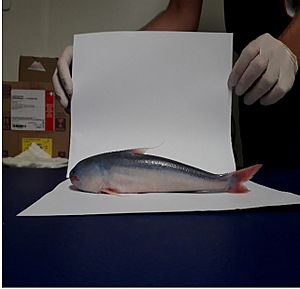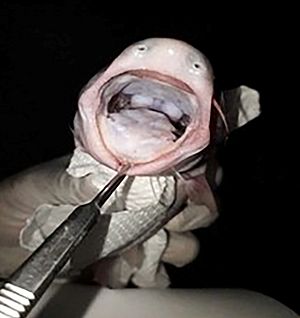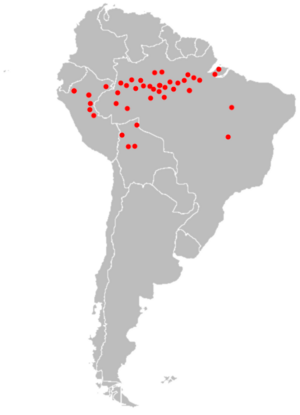Candiru cobra facts for kids
Quick facts for kids Candiru cobra |
|
|---|---|
 |
|
| Candiru açú, thought to be either Cetopsis candiru or Cetopsis coecutiens | |
| Scientific classification | |
| Genus: |
Cetopsis
|
| Species: |
candiru
|
The Cetopsis candiru, also known as candiru, candiru açú, candiru cobra, or canero, is a type of whale catfish. This fish eats meat and lives in the Amazon basin in Peru, Brazil, and Bolivia.
Cetopsis candiru is a large fish in its group. It is known for eating a lot and for burrowing into dead animals and even humans. Even though it shares a name with the Candiru (Vandellia cirrhosa), which is a bloodsucking fish, they are not closely related.
Contents
Names of the Candiru Fish
This fish has many different names depending on where it lives. In Bolivia, people call it "Canero" or just "Candiru." The name "Canero" is also used in Peru.
Sometimes, people use "candiru açú," but this name is mostly for other fish in the Cetopsis group. Another name for it is "candiru cobra." The name "Candiru" can be confusing because it's also used for Vandellia cirrhosa. That fish is a parasitic catfish, but it's not related to the Cetopsis family.
What the Candiru Fish Looks Like
The Cetopsis candiru has a long, smooth body. Its head is wide and shaped like a triangle. Its eyes are small and located on the top-sides of its head, very close to the front. They are about the same size as its front nostrils. It also has a second pair of nostrils further back on its head, which open upwards.
The fish's mouth is low on its head and is about half as wide as its head is long. The lower jaw is shorter and reaches back about as far as its eyes. Its front teeth are flat, like incisors, and form a single curved row. It also has similar teeth on the roof of its mouth and on its lower jaw. These teeth are bigger on the lower jaw. This is different from its relatives, which have cone-shaped teeth.
Like many other catfish, Cetopsis candiru has long, whisker-like growths called barbels. The barbels near its mouth are about a third of the length of its head. It also has two pairs of barbels on its lower jaw, which are the same size as the ones near its mouth.
The dorsal fin (the fin on its back) is small and located towards the front of its body. It does not have any sharp spines. The part of its body before the tail fin (called the caudal peduncle) is about as deep as it is long. The caudal fin (tail fin) is symmetrical and slightly forked, with rounded parts.
The anal fin (fin on its underside near the tail) is in the back half of its body. It is gently curved and does not attach to the body at the very end. The pelvic fins (fins on its belly) are short and shaped like paddles with rounded edges. Like the anal fin, their last fin ray does not attach directly to the body. Finally, the pectoral fins (fins on its sides, behind the head) are about half as long as its head and have rounded edges.
Adult male Cetopsis candiru look a bit different from females and younger fish. The first fin rays of their dorsal and pectoral fins are longer. Their anal fin is also more curved. Scientists are not sure exactly when these changes happen. The smallest male fish showing these traits was about 14.5 centimeters (5.7 inches) long.
Cetopsis candiru is one of the largest fish in its group, along with C. coecutiens. They can be as small as 1.8 centimeters (0.7 inches) and as large as 26.3 centimeters (10.4 inches).
Ecology and Habits
Cetopsis candiru is a fish that eats meat. It is known for eating a lot. It has strong jaw muscles and sharp, flat teeth that help it cut through things. This fish often lives in the same areas as its relative, Cetopsis coecutiens. Both species are known to eat from the same dead bodies.
However, they have different ways of feeding. Cetopsis candiru usually bites into a dead body and twists to make a hole. Then, it goes inside the body to eat. Many of these fish can gather inside a carcass during a feeding frenzy. Because of this, bodies eaten by C. candiru often look like almost all the flesh is gone, but the cartilage, eyeballs, and tight skin remain.
Cetopsis coecutiens, on the other hand, does not stay inside the body. Instead, it comes back many times, ripping off pieces of flesh each time. Both types of fish leave similar round bite marks on the bodies they scavenge. These fish are "opportunistic," meaning they eat whatever dead animals fall into the water. They are important scavengers in the Amazon, helping to clean up the environment.
There is one confirmed report of a Cetopsis fish attacking a living child. However, it was not clear if it was C. candiru or C. coecutiens. Other reports mention Cetopsis candiru eating live fish caught in fishing nets or on hooks.
Where the Candiru Fish Lives
Cetopsis candiru is found in many parts of the Amazon Basin. They have been found in Brazil near the Amazon River itself, as well as in the Rio Tocantins, Rio Negro, Rio Purus, and Rio Madeira rivers.
In Bolivia, they live in various rivers that flow into the Rio Madeira, like the Rio Beni. In Peru, they have been found in the Rio Ucayali and other rivers that flow into the Amazon. Some scientists also say that Cetopsis candiru lives in eastern Ecuador.
About its Family Tree
Cetopsis candiru was first described by scientists Spix and Agassiz in 1829. Over the years, it has been given a few different names, but Cetopsis candiru is the one that stuck.
Studies show that Cetopsis candiru is closely related to two other species: the large Cetopsis coecutiens and the tiny Cetopsis oliveirai. It's interesting because these three fish are very different in size. They were even placed in different groups in the past. However, scientists now agree they belong together within the Cetopsis group.
See also
 In Spanish: Cetopsis candiru para niños
In Spanish: Cetopsis candiru para niños



